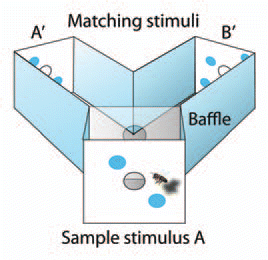Figures & data
Figure 1 The “magical number four”: Presentation of honeybees in ancient Egypt. (A) 4th dynasty (∼2613–2404 B.C.), Roemer-Pelizaeus-Museum, Hildesheim, Germany; (B and C) 5th dynasty (∼2500–2350 B.C.) and (D) 19th dynasty (∼1292–1186 B.C.), Egyptian Museum in Berlin-Charlottenburg, Germany, reproduced with permission.

Figure 2 (adapted from Pahl et al.Citation13). Delayed match-to-sample (DMTS) setup in a Y-maze. The bee has to memorize the sample stimulus A (two blue dots) and to recall it when deciding for one of the two matching stimuli A' or B' inside the maze. The exit A' leads to a reward (a sugar solution) in this example. The location of the reward was randomized irregularly among A' and B', respectively. During testing, the arrangement of dots differed between the entrance A and the correct exit A'. In order to make the task much more difficult, the dots were arranged in randomized orientations between stimulus A and A'. Finally the dots were replaced by novel objects some of which the bees had never seen before: yellow lemons, green leaves, yellow stars or blue dots in random orientations.Citation6 Baffles behind the exits A' and B' prevent the bees from seeing the reward. In this context it is relevant to remember that the duration of the visual working (short term) memory of the honeybee is less than 10 seconds.Citation14.

Table 1 A summary of 1,027 trials to determine the precision of numerical discrimination when sequential counting is prevented (modified from JevonsCitation2)